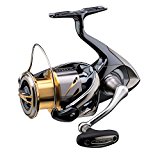Roanoke Bass Summer Fishing Information and Facts
If you are casting a bit of a distance, attach a bobber/float to the line to keep the bait at the right level.
Fishing for Roanoke Bass in the summer does not differ much from fishing for them is the spring, though spawning is over once summer comes along so you won’t have to feel guilty about taking a Roanoke Bass away from creating young Roanoke Bass.
Roanoke Bass do not like the high sun and heat of the summer months. As the sun comes up, the Roanoke retreat back to their protective shoreline outcrops, rock outcrops, sunken logs and other sunken debris that offers them cover.
However, it is important to know one more thing about the cover they seek out. Any sunken log or shoreline outcrop must be deep enough. The Roanoke Bass prefers temperatures in the 60°F to 70°F/15°C to 21C° degree temperature range. From our experience, it is not uncommon to find the Roanoke Bass down between five to seven feet deep, though they will go deeper if the water temperature warms up. They also go deeper when winter arrives.
Night
Roanoke bass are more active at night than they are during the day. They spend most of the day hiding from the sun, laying in wait for prey to swim by where they will strike, but they will not go looking for them. The best night time fishing is at dawn and dusk. Night time fishing is best when daytime activities on the river are busy with human activity such as boating, swimming and jet skies. During these conditions, they will not eat, which makes them far more hungry at night.
Above: busy daytime activities are not limited to recreational activities. Construction creates translates vibrations to the water creating a lot of noise.
Tackle
While you can deck out with the greatest light spin casting tackle, tiny jigs, doll flies, streamers and small crank baits that imitate wounded minnows and even use small spoons and spinners, this is a little bit of an overkill. Roanoke Bass are not hard to catch and do not required specialized hardware. A simple 1/0 straight hook with an Earth worm on it will be sufficient.
If you are casting a bit of a distance, attach a bobber/float to the line to keep the bait at the right level. The key to a float is to use one that is just buoyant enough to keep it halfway above the water line so that when you get a nibble you will know when to set the hook. Quite often, you will get perch or sunfish after your bait as well, which will be more of a nibble than an outright strike.
Fly Fishing
Anglers can also try fly-fishing for Roanoke bass with wet flies, but this only works in shallow waters as they are normally bottom feeders. Cast your line so that the bait rest close to the bottom as rock bass are primarily bottom feeders. Where the bottom is free from logs and other items that cause snags, run your bait across the bottom, allowing it to jump from time to time. But if you don’t have any fly tackle, don’t waste your money getting fly gear just for this fish – that would be silly


